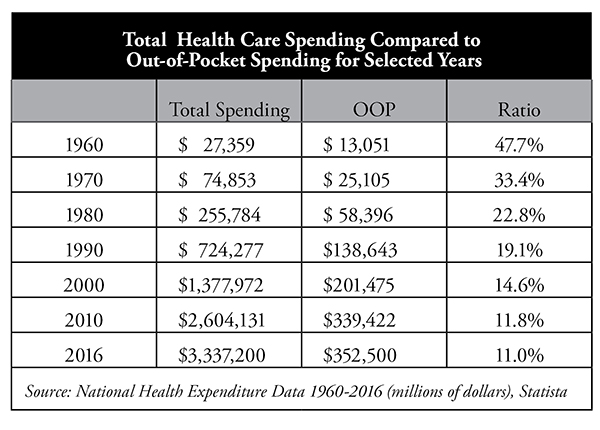By: Merrill Matthews – ipi.org – October 2, 2018
Synopsis:
The health insurance system has failed America. Most of the blame lies with state and especially federal government intervention. Lawmakers have increasingly abandoned long-standing actuarial principles, culminating in the Affordable Care Act. The result is insurers are increasingly covering small and routine health expenditures and exposing patients to very expensive costs, turning the principle of health insurance upside down. Short of repealing Obamacare, Congress should give insurers enough flexibility to operate outside of the current restrictions.
Introduction:
The health insurance system has failed America. While health insurers played a role in that failure, most of the blame lies with federal and state government intervention and micromanagement—and arguably mismanagement. In essence, the more federal and state politicians and bureaucrats tried to improve access to quality, affordable health insurance, the less access people had—with the final blow coming from President Obama’s misnamed Patient Protection and Affordable Care Act.
Can the health insurance system be fixed? Maybe, but only if politicians are willing to let it function like real insurance rather than using it as a social justice tool to achieve their vision of “fairness”—and their chances of reelection.
How Insurance Is Supposed to Work—and Why
The principle behind any type of insurance is simple: People or businesses face a risk and want to avoid the full cost of that risk if it occurs. So, for example, individuals who want to limit the financial risk of death may buy life insurance. Those who want to reduce the risk of financial loss if their homes are robbed or destroyed buy property insurance.
In each case the applicant applies for coverage and the insurer assesses the risk the applicant brings to the insurance pool and charges a premium based on that risk—or declines to offer coverage if the risk is too high.
That’s why young people, who have a lower statistical risk of death, will typically have a lower life insurance premium than older people. On the other hand, older adults may face lower auto insurance premiums than younger people, especially males, who tend to be more aggressive drivers.
Underwriting insurance policies has been a very successful model backed by centuries of experience. Insurers’ ability to decline coverage or charge high-risk applicants more encourages individuals and companies to enter the insurance pool before an unforeseen incident occurs and avoid risky behaviors, both of which are essential for a stable insurance market.
Why Health Insurance No Longer Works
Most insurance markets—life, property, auto, etc.—still rely on standard actuarial principles. Not health insurance.
While health insurance pre-dated World War II, it began expanding during the war when employers, who couldn’t boost wages because of wage and price controls, began offering health coverage to attract good workers. That expansion gained momentum when the IRS ruled in 1943 that employer spending on coverage would be tax-free to the employee—a “tax exclusion” because the money spent on coverage is excluded from income.
That coverage was essentially hospital coverage, which represented the primary financial risk in health care. But because employer-provided health insurance is excluded from personal income tax, and because workers (incorrectly) believe the cost of coverage comes out of the employers’ pocket rather than their own, workers and their unions wanted more of it. The result is, over time, employer-provided coverage became more and more comprehensive, increasingly insulating employees from the cost of care.
As the table shows, in 1960 patients paid nearly 48 percent of all health care spending out of pocket (OOP). By 2016, total out-of-pocket spending had declined to about 11 percent. However, after the implementation of the Affordable Care Act in 2014, with its very high (and growing higher) deductibles—especially for bronze-level plans—and other coverage changes, out-of-pocket spending is likely to rise again.
That decades-long trend toward lower OOP spending fundamentally changed the nature of health insurance and the way people consume health care. Patients simply had little reason to worry about health care prices or how much they were spending.
The Government Gets Involved […]
Perverse Economic Incentives Drive the System […]
Obamacare Doubles Down on Bad Economic Incentives […]
Health Insurers Limit Care […]
Insurers Restructure Coverage Options […]
Attracting the Healthy […]
The Height of Hypocrisy […]
Health Insurance That Is No Longer Insurance […]
Is There a Solution? […]
Short-Term Policies […]
The HSA Option […]
Direct Pay […]
Promote Supplemental Coverage […]
Block Grant ACA Money to the States […]
Conclusion […]
To see the remainder of this article, click read more.
 Listen Online
Listen Online Watch Online
Watch Online Find a Station in Your Area
Find a Station in Your Area










 Listen Now
Listen Now Watch Online
Watch Online
